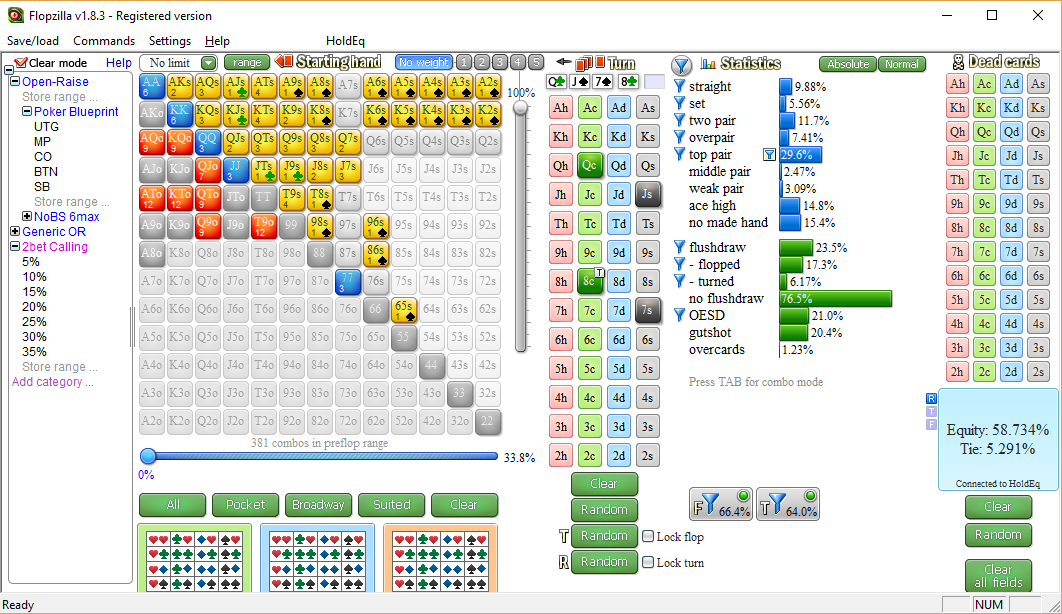Introduction
I have been reading lately over and over again an Excerpt from Ed Miller’s 1% book that goes over a couple examples on playing poker with a very different approach than the classical hand reading method. It’s not revolutionary, but the way he explains it really blows my mind. This approach is playing the frequencies rather than our opponent’s range or our own hand for that matter.
By this frequency method, we should be calling about 70% of our hands from previous streets to basically make our opponent’s life a living hell postflop and to not throw money away if our opponent is paying attention to our high folding frequency when we don’t catch a strong hand. This prevents putting us in tough spots in the future with this opponent.
I really love this approach, because it’s more of a set and forget method. Maybe you haven’t read my posts about trading, but poker and trading have so many similarities that I will probably do a post just about that topic.
Sorry I am getting a bit off topic, but I find it fascinating!
Back to our practice, I wanted to try Ed Miller’s approach with a random board and some standard ranges both for opening and defending, we playing the defending side.
The Ranges
Let’s say for the sake of this hand reading practice that our opponent is opening from the BTN and we are defending the BB. This is how the ranges look on Flopzilla:
| Opponent’s opening range | Our calling range |
|---|---|
 |
 |
The Flop
I am plugging a random flop to begin our analysis:

Still quoting Ed Miller’s work, this is a very dynamic flop, meaning that it offers many draws as well as made hands for the ranges we are using here. This flop favors slighly more the BTN’s range because he has position on us and could pull some strong lines, putting us in tough spots in future streets.
What does our 70% range looks like?
Let’s assume our opponent is betting this flop if we check all of his gutshots and better draws as well as his middle pairs or better. For him, this range represents 65% of his opening range.
We will try to defend about 70% of the time, so we will call/raise (depending of the type of player you are) with our middle pairs and better as well as our gutshots and better draws. I’m also adding the pair of TT as a weak pair because it also has some draw potential.
This is how our ranges are looking so far:
| Opponent’s range | Our range |
|---|---|
 |
 |
So far, we have a slight advantage, but it’s basically a coin flip with this board.
The Turn
I am plugging a random turn card:

We check again and our opponent bets. He probably is doing this with his OESDs and FDs as well as with some of his top pairs (9 kicker+ for a top pair and gutshot) and better.
We are defending again (calling or raising) with our JTs for a middle pair + gutshot and better made hands as well as our OESDs and FDs. This is 75% of our previous range.
Here is how the ranges look:
| Opponent’s range | Our range |
|---|---|
 |
 |
We have 41% equity against his betting range, so we can still call or raise profitable as we did.
The River
Let’s plug a random river card:

We once again check and our opponent bets. He could be doing this with his better two pair combos and better. We will again try to defend with 70% of our previous range, so this consists of our KQ combos, our A top pairs that missed the draws and better hands.
Let’s check the ranges at the end of the hand:
| Opponent’s range | Our range |
|---|---|
 |
 |
As we can see, we have 29% equity against our opponent’s range, which is not bad at all, this means we can call a 3/4 pot sized bet and be breakeven (we need 30% equity), if it’s less than that we are making a profitable call each time.
Conclusion
This exercise has been very powerful to get a grasp of Ed Miller’s concept. All it takes is practice, practice and practice to develop the intuition at the tables and we will be ahead of the vast majority of players.
I hope you liked this hand reading exercise and that we all can put it in practice next time at the table!!!
Please Comment, Vote and Follow if you like it.
Best regards,
@daniel.dalo

Leave a comment